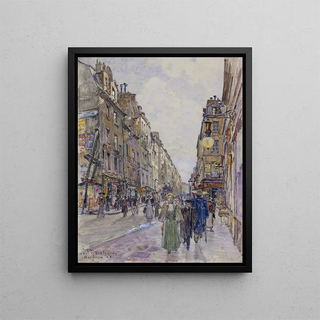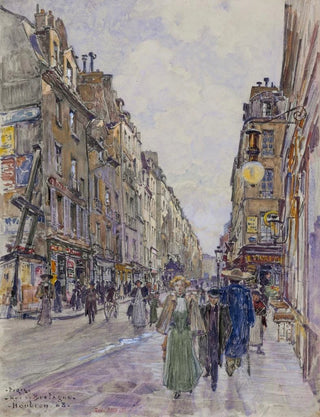Painting Rue de Bretagne in 1908 3rd arrondissement - Frédéric Houbron | Art print


View from behind

Frame (optional)
In the artistic buzz of the early 20th century, the art print "Rue de Bretagne en 1908" by Frédéric Houbron stands out with its unique perspective on Parisian life. This piece, capturing a snapshot of everyday life in the 3rd arrondissement of Paris, evokes a vibrant and nostalgic atmosphere. The scene, bathed in soft light, transports us to a world where the past and present meet, where every street corner tells a story. Through this work, Houbron invites us to stroll through cobbled alleys, feel the city's pulse, and appreciate the beauty of simple moments.
Style and uniqueness of the work
Houbron’s art print is distinguished by its Impressionist style, where light and color play a leading role. The brushstrokes, both delicate and expressive, create a lively texture that brings the canvas to life. The color palette chosen by the artist evokes a gentle melancholy, with shades of blue, green, and earth tones blending harmoniously. This chromatic choice, combined with a carefully orchestrated composition, captures the very essence of the street, animated by passersby, shops, and historic buildings. The way Houbron captures shadows and lights demonstrates a technical mastery that transcends mere visual rendering, offering the viewer a total immersion in the moment.
The artist and his influence
Frédéric Houbron, an emblematic figure of French art in the early 20th century, successfully combined tradition and modernity in his work. Trained in Parisian art schools, he was influenced by the great masters of Impressionism while developing a style that is uniquely his own. His art print reflects not only his attachment to the city of Paris but also a particular sensitivity to scenes of daily life. Through his canvases, Houbron managed to capture the soul of the capital, making his works valuable testimonies of a bygone era. His influence is felt among many contemporary artists, who continue to explore themes of the city and the intimate, inspired by his

Matte finish

View from behind

Frame (optional)
In the artistic buzz of the early 20th century, the art print "Rue de Bretagne en 1908" by Frédéric Houbron stands out with its unique perspective on Parisian life. This piece, capturing a snapshot of everyday life in the 3rd arrondissement of Paris, evokes a vibrant and nostalgic atmosphere. The scene, bathed in soft light, transports us to a world where the past and present meet, where every street corner tells a story. Through this work, Houbron invites us to stroll through cobbled alleys, feel the city's pulse, and appreciate the beauty of simple moments.
Style and uniqueness of the work
Houbron’s art print is distinguished by its Impressionist style, where light and color play a leading role. The brushstrokes, both delicate and expressive, create a lively texture that brings the canvas to life. The color palette chosen by the artist evokes a gentle melancholy, with shades of blue, green, and earth tones blending harmoniously. This chromatic choice, combined with a carefully orchestrated composition, captures the very essence of the street, animated by passersby, shops, and historic buildings. The way Houbron captures shadows and lights demonstrates a technical mastery that transcends mere visual rendering, offering the viewer a total immersion in the moment.
The artist and his influence
Frédéric Houbron, an emblematic figure of French art in the early 20th century, successfully combined tradition and modernity in his work. Trained in Parisian art schools, he was influenced by the great masters of Impressionism while developing a style that is uniquely his own. His art print reflects not only his attachment to the city of Paris but also a particular sensitivity to scenes of daily life. Through his canvases, Houbron managed to capture the soul of the capital, making his works valuable testimonies of a bygone era. His influence is felt among many contemporary artists, who continue to explore themes of the city and the intimate, inspired by his
12,34 €






